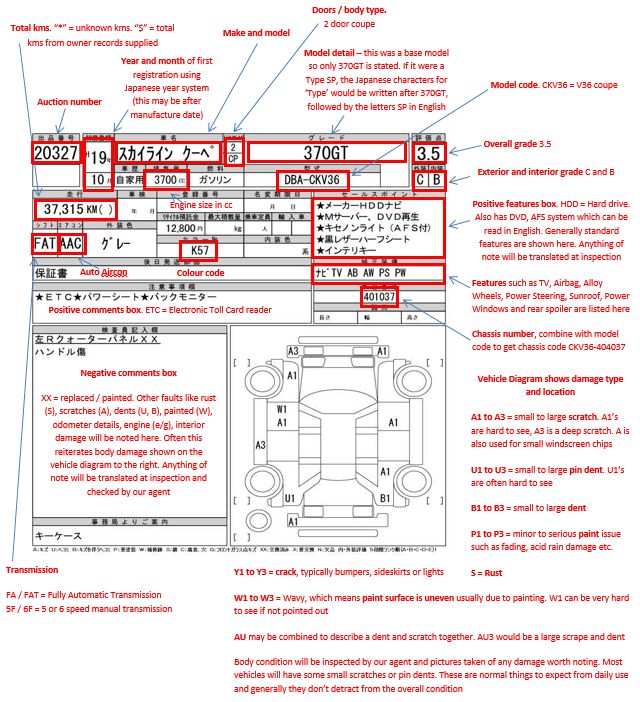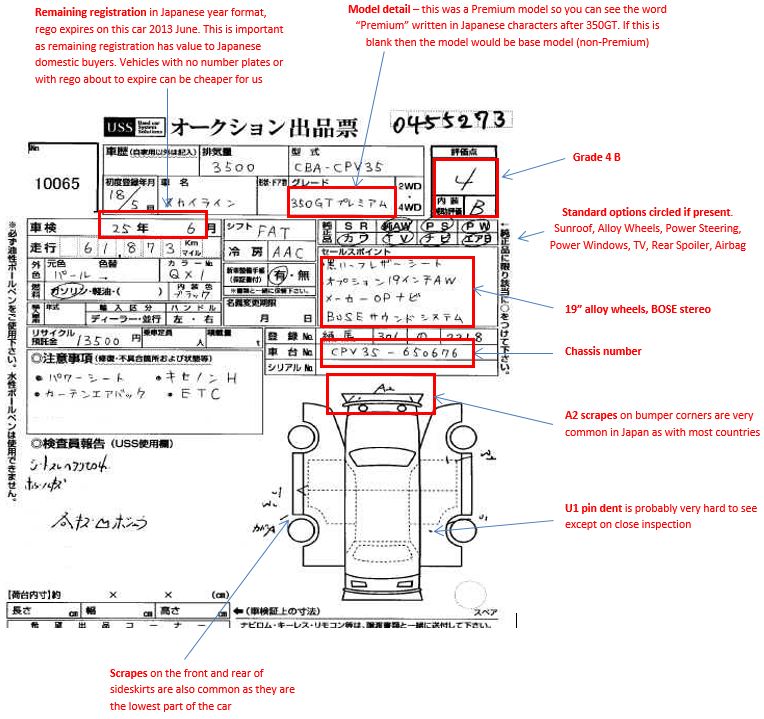Japanese Auction Sheet Codes Explained
Japanese auction sheet
Every auction uses a grading report or Japanese auction sheet which lists the details of the vehicle plus information about the vehicle condition.
Each auction house is a little different in the reporting format but the basic information remains the same.
Vehicles are given from 0 to 6 for the overall grade (6 is the best) with A to D used for interior grade (A is the best).
Some auctions will add an extra A to D grade for body condition, so you may see a 4 B B for example.
Interiors graded A should be virtually as new.
B is also considered extremely clean, and C is often used for average condition.
For some auctions a C is still very good, while at others it will mean the interior is dirty, has cigarette burns, or obvious wear and tear.
C for a vehicle older than 10 years is generally expected, but would be cause for concern on a 2-year old vehicle.
D usually means very untidy, dirty, smoke-affected, or stripped out for racing.
Grade 3 or 3.5 can also be the result of a minor accident repair.
Repairs are usually denoted with XX on the affected panels, but can be hidden in the auction sheet notes section written in Japanese.
Very minor repairs to front panels may be considered where it’s obvious that only bumpers or front panels have been repainted and any parts replacement has not affected the front structure.
If there is any doubt about this we will avoid the vehicle as it is simply not worth the risk of rejection by your compliance workshop.
Occasionally a lower grade vehicle might be worth considering, e.g. some large scrapes and scratches on the bodykit / bumpers could result in a 3.5 or 4 grade for what is otherwise a nice vehicle.
This cosmetic damage may be easy to fix yet result in significant savings on newer vehicles.
Grade 2 indicates very poor condition or water damage.
Grade 1 is a sign of ‘significant modifications’ – this could be performance upgrades such as larger turbos, a transmission change from auto to manual, an engine change, or prepared for racing.
It is therefore a matter of reviewing the Japanese auction sheet and pictures for any vehicles of interest with an open mind to determine those worth further inspection.
Any that look promising will be physically inspected by our agent at auction to confirm actual condition and more pictures will be taken.
We then contact you to discuss condition and your budget.
See What We Do for more detail on the auction inspection and bidding process.
Overall Grade
6> New
5> As new with no condition faults
4.5> Very clean, one panel affected by minor paint blemish
4 > More than one panel affected by minor paint blemishes
3.5 > Some attention to panel and paint is required
3 > Rough overall condition
2 > Serious panel damage, rusty or water damaged
1 > Significant performance upgrades or mechanical changes
A, 0, R > Accident damage and repair
A, 0, R >and variations (RS, R0, RA, A1) are all used to denote repaired vehicles, with RA, A1, R1 being minor repairs. Repairs in the rear or any dents in structural members like chassis rails are exclusions for Australia under SEVS so we immediately avoid any of those vehicles for SEVS import.
*** Serious mechanical or body fault, e.g. engine problems, existing accident damage, fire
Interior
A > As new with no condition faults
B > Very clean and nice
C > Average / clean for age including expected wear and tear
D > Cigarette burns / smell, rips, tears, or other damage to interior, significant wear and tear
Options
SR> Sunroof
AW> Alloy Wheels
PS> Power Steering
PW> Power Windows
AB> Airbag
Vehicle Diagram
XX > Panels have been replaced due to repairs and / or painted.
W> Wavy
Can mean the affected panel has been painted, and the paint is not as smooth as the original factory paint.
However, in some cases even when marked with a W it is impossible to tell with the naked eye whether paintwork has been done.
Auction staff can make mistakes also, and mark panels W when they are uncertain. W or W1, W2 and W3 are used, with 1 being least noticeable.
A Scratch
A1 is a tiny scratch, and generally you would expect this to buff out or be an easy touch up.
A2 is a medium scratch through the top layer of paint, and won’t easily be hidden.
A3 is a deep scratch such as a serious scrape or intentional key mark, and will definitely require paintwork if you want to fully address it.
U Pin dent
Only a small dent such as you would pick up in the carpark.
U1 to U4 are used to denote the size of the dent, with 1 being the smallest.
B Larger dents
These are more serious than pin dents. They are quite noticeable dents and range from B1 to B4.
G Chip
You might see a G, X or even an A marked on the windscreen. This usually indicates a small stone chip or scratch and often these are quite small, the size of a pin head or so, and not easily visible.
They are the sort of things most cars pick up through normal use and if you see them noted it doesn’t mean the windscreen needs replacing.
Y Cracks
Y1 to Y4. Usually in bodykits or lights and often not a major issue as repair or replacement is fairly simple.
P Paint damage
P1 to P4. Fading, scratches or discolouration from sun damage, polishing, peeling, crazing or poor paintwork.
S / C Rust / Corrosion
S and C1 to C4 are generally used.
An S or C1 on the body can mean a small stone chip has some surface rust or there is a spot of rust on the edge of a sunroof which might be easily addressed.
In other cases S noted in the negative comments section could indicate extensive underbody rust. C indicated on the wheel arches is a sign there is serious corrosion due to use in snowy areas.
Physical inspections are undertaken for rust regardless of whether it is noted on the Japanese auction sheet, as even grade 4.5 vehicles can be rusty.

